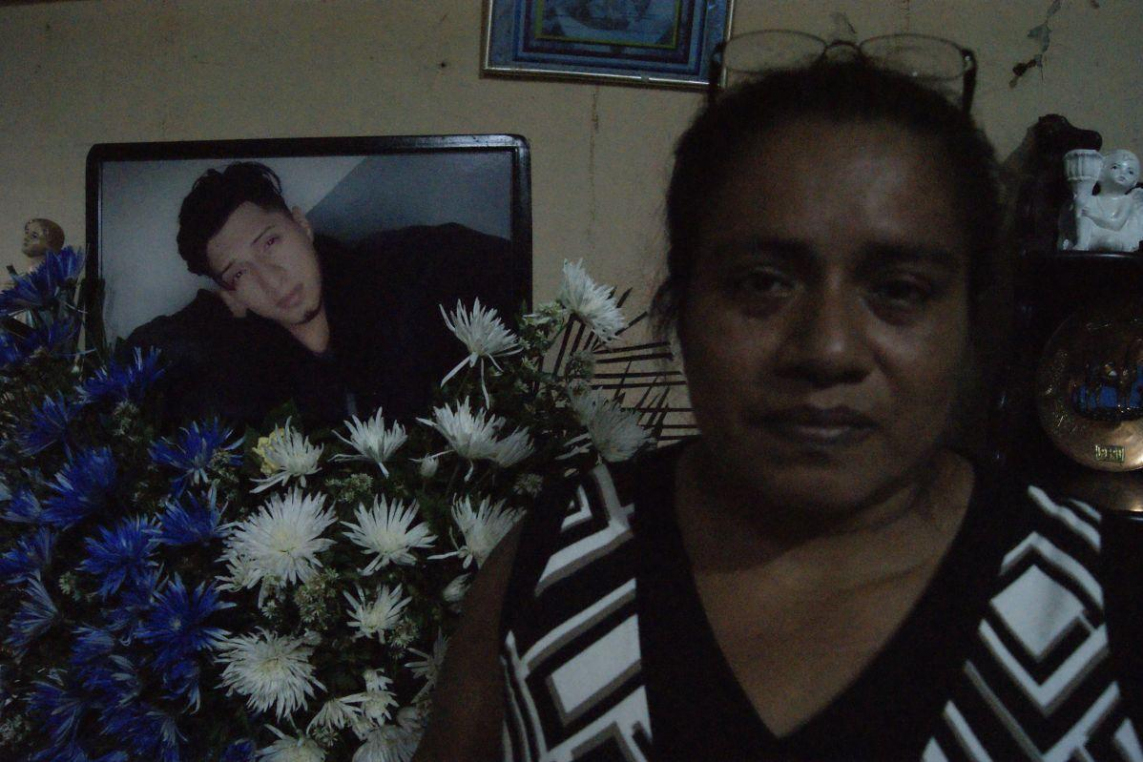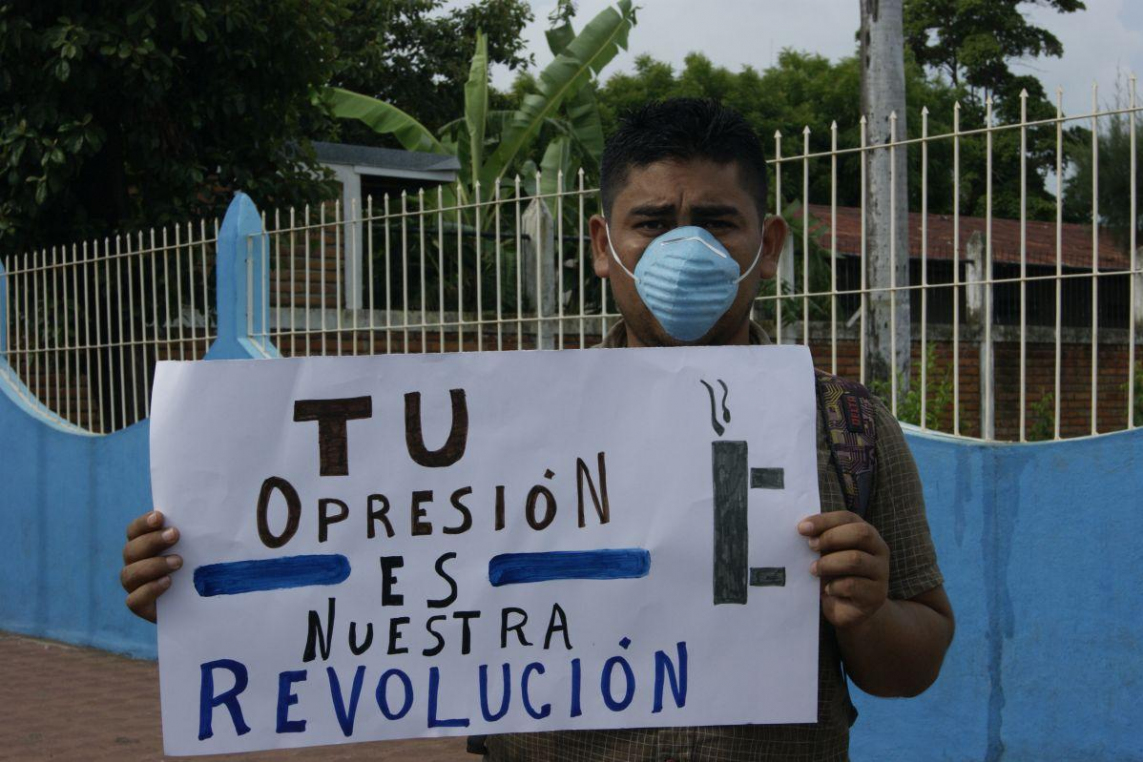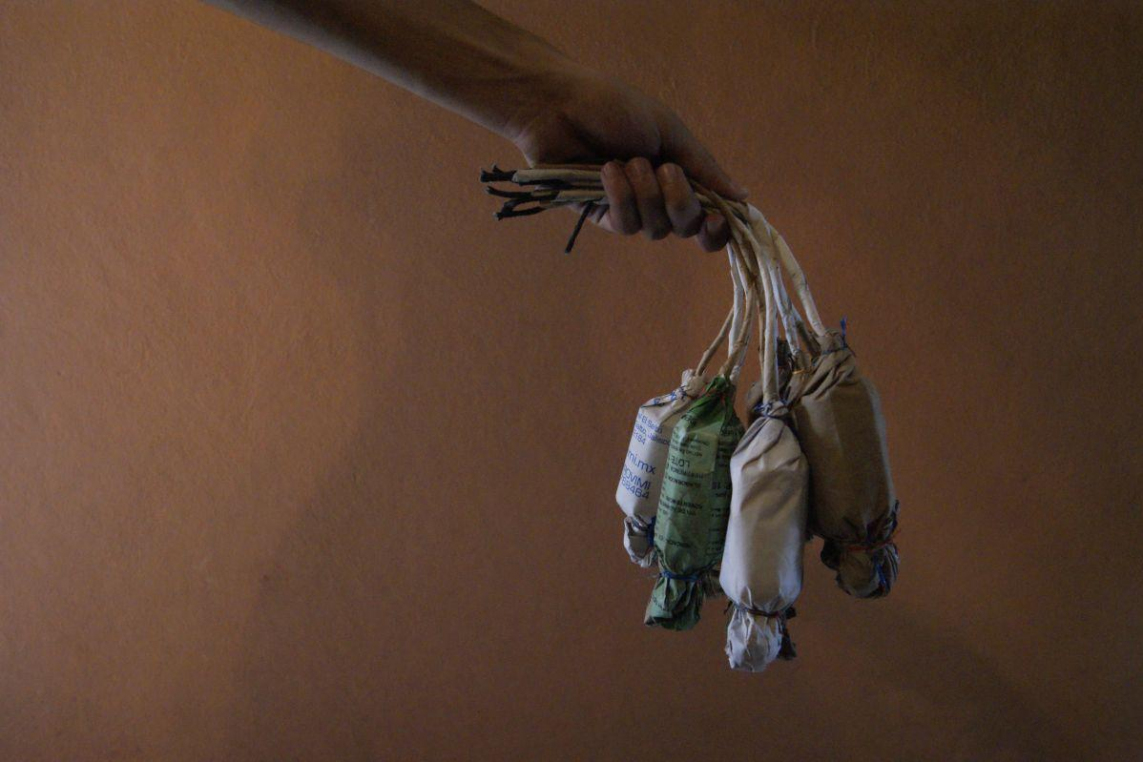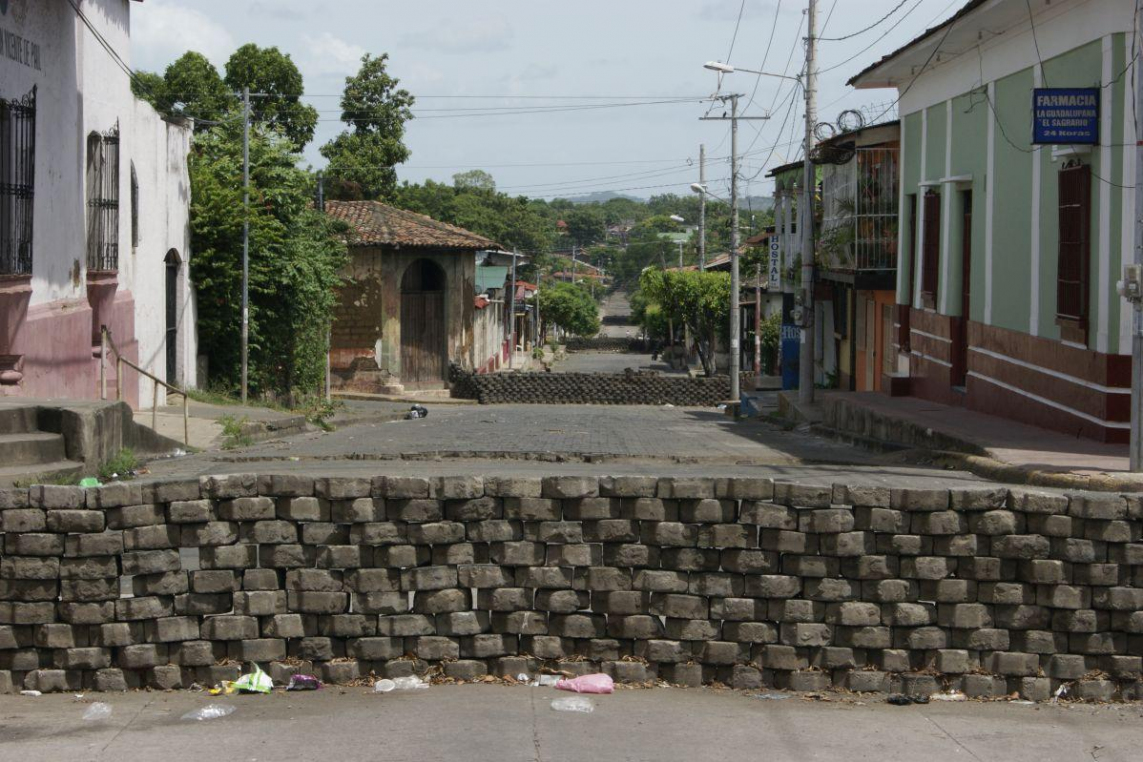Frauke Decoodt heeft een verleden in activisme, antropologie en journalistiek. Ze leefde van 2010 tot 2012 in Guatemala en van eind 2015 tot mei 2017 in Honduras.
Surviving violence and Ortega in Nicaragua
“They killed my son. It hurts so much, it crushes me.” With a low voice Patrona del Carmen tells the story of her 22 year old son José Casco. José is one of the more than 300 killed in Nicaragua since the popular uprising began on the 18th of April.
José, everybody called him El Chino, grew up in El Viejo, a small town close to the Honduran border. At this rundown family house Patrona sits down beneath a massive picture of him adorned with plastic flowers in blue and white, the colors of Nicaragua’s flag and of the movement he died for on the 5th of June.

El Chino’s mother
© Frauke Decoodt
This dark empty room recently served for the wake, a ritual that takes ten days in Nicaragua. Still various family members are silently scattered in the house. Patrona’s daughter and second husband stay close to support her. She speaks with a monotonous voice that cannot allow itself to cry, because it would be impossible to stop.
“Leave the protesting to others”
As a single mother it was a struggle to support her son and daughter. “I process pork and sell the prepared foods in the street. My son often helped me but he said “Mamita, I want to study, I don’t want you to do this work anymore”. I did what I could to pay for his studies, sometimes other family members helped. When I could I made his breakfast which he would eat for lunch. Last year we couldn’t afford it anymore and he had to stop studying but this year we tried again.”
At university El Chino made new friends and ideas. “My son was never very interested in politics, but the changes to the social security system concerned him. I told him to leave the protesting to others, we were too poor to even receive a benefit. He responded that this matters to everybody and added that what upset him most of all was to see old people getting beaten when they were only expressing their discontent.”
The pressure cooker explodes
On the 17th of April president Daniel Ortega approved reforms to the social security system, including a small rise in contributions. One day later students and pensioners took to the streets. Images of pensioners beaten by pro-government groups spread like wildfire on social media. Many more joined the protests which were heavily repressed by police and pro-government militia. When the first deaths were counted people poured onto the streets, on the 20th people were speaking of an popular insurrection.

“Your Repression is our Revolution”
© Frauke Decoodt
“Compare it with a pressure cooker.” Before visiting the mother of el Chino there is a stop by his friends. They only recently met at the protests but quickly became a solid affinity group. Anita*, a twenty year old girl, explains, “For years the tension was building. People had enough, enough of the corruption, the authoritarianism, the abuse of power and repression. It just suddenly exploded.”
A conspiracy and coup to oust Ortega
Ortega and his FSLN (Frente Sandinista Liberacion Nacional) paint him as a socialist leader who never stopped defending the ideals of the Sandinista revolution in 1979 which toppled previous dictator Somoza and inspired so many worldwide. Within and outside Nicaragua loyalists of Ortega repeat his adage that the present uprising is a CIA conspiracy and a coup of the conservative Nicaraguan elite.
“Such a massive and sudden uprising cannot be a mere CIA plot.”
The Nicaraguan business elite has indeed, after years of collaborating with Ortega, joined the opposition. Some protesters have certainly had questionable meetings with neoconservative in U.S. Congress. There are undeniable foreign and local conservative influences in these protests.
Jorge Lopez*, an ex-combatant of the FSLN who dedicatedly fought in the revolution and the war that followed it, strongly objects the conspiracy theory. “Such a massive and sudden uprising cannot be a mere CIA plot.” When asked, most protesters do not deny the possibility of manipulation, outside interference and the hijacking of their movement. As happens in most uprisings is the detection and countering of this possibility not their first priority. They have a regime to topple.
Nicaraguans are fed up
The resistance to Ortega and his wife, as well as his vice-president Murillo is not new, and does not come from conservatives alone. Feminists fought the total ban on abortion. Indigenous peoples struggled against the colonists pouring into their territories. Peasants and environmentalists opposed neo-liberal projects such as inter-oceanic canal and open pit mines. Workers were angry about the inability to obtain a job without FSLN party credentials.
Old Sandinistas disproved of reducing the FSLN party to the personal project of Ortega and Murillo and turning state assets into a family enterprise. Citizens were angered about the violations of the Constitution, the rigging of the elections, the manipulation with gifts and violence, the control of media, police, congress and municipalities.
The revolutionary turned dictator
The revolutionary leader Ortega had become the dictator and caudillo he once fought. Although he brought relative peace and stability to the country those who opposed his regime were harshly repressed. The current violence that pro-government forces inflict is nothing new, only the scale is.
“Since his return to power in 2007 the USA and Nicaraguan businesses felt very comfortable with Ortega.” the ex-sandinista Jorge asserts. “The CIA is not the cause of the many reasons why Nicaraguans had enough, Ortega is.”

Gunpowder for the handmade mortars
© Frauke Decoodt
The social security system issue sparked a discontent that had grown for years. The lethal repression that before always worked to induce fear and obedience, was the fuel that ignited the fire even more. All over the country students were joined by other variously fed up Nicaraguans from different sides of the political spectrum. A diverse movement began to take shape.
“Don’t worry mamita”
On Nicaraguan Mother’s day, the 30th of May, saw one of the biggest marches in Nicaragua in solidarity with the mothers who lost their children in the violence. At the end of the march sixteen more mothers grieved their child. Whenever Chino left to the protests she feared she would become one of them She begged him not to go and sat waiting in a chair until late at night until he returned. That last night she asked him again not to return late. He told her not to worry. He would only go to the medical center.
Instead he went with his new friends to set up a barricade in Chinandega, a nearby town. Soon after they got there armed pro-government militia arrived. Most fled but Chino stayed behind with a handful of his friends. He had problems lighting his homemade mortar. A paramilitary sniper shot him in the abdomen. His friends tried to bring him to the hospital on a motorcycle but he died on the way.
“My son defended a just struggle”
“They took a part of me, my son. He still had so many dreams. Still I sit up waiting for him at night.” El Chino’s mother continues, “I cannot forgive, that is up to God.” Less convincing she adds, “I hope one day there will be justice and that the ones hurting our people and killing our youth are punished.”

Building a barricade
© Frauke Decoodt
The violence that took her son also made Patrona more involved. “I cannot go out on the street because it’s dangerous and I still have family that needs me. But I am willing to help all I can because the struggle of these boys is a just struggle, because my son defended it.
The words of Jorge, the ex-combatant, resonate. “Each kid that is murdered has a family, friends, a neighborhood. With each kid that is murdered the movement to overthrow this regime will grow.”
Who kills how and with what?
Since the 18th of April more than 300 people died. Many more have been wounded, detained and disappeared. Numerous videos, testimonies and investigations from national and international human rights organizations, such as Amnesty International and Human Rights Watch or the IACHR from the OAS, demonstrate that pro-government forces are responsible for the majority of the violence.
Paramilitary militia, frequently in close coordination with police terrorize, kidnap, torture and execute. These killings are often intentional, not stray bullets, but precision shots that aim to kill, with high caliber weapons fired by professionals.
Although the military have declared they will not take sides many argue these weapons and skills can only come from them. Not taking sides is moreover increasingly seen as being complicit.
“The hospital closed its doors on us”
The violence is not only directed against protesters. In Leon a doctor from a medical brigade feared for her life while she was saving people. “We set up the medical brigades because on the 20th of April there was massive repression. When I saw an old men with a real bullet wound I realized they were shooting to kill. So many got hurt, but the hospital closed its doors on us.”
Although Doctor Esmeralda Sanchez works a few hours a day in a government funded hospital, she spends her remaining time in support of the movement fighting the government. Her house is full of medical supplies to take to barricades. Whenever violence erupts she and her young student friends run towards it, to take care of the wounded.
“I think what inspired me the most, was to see how these youngsters from our brigades ran between bullets risking their lives to help others.”
“On the 23rd of May a group of about 300 marched in Leon to show support for the government. Masked mobs attacked the barricades. I think what inspired me the most, was to see how these youngsters from our brigades ran between bullets risking their lives to help others.”
The doctor speaks still impressed by the events. “There were three medical posts. We attended people from both sides. Our little room was full of wounded. Suddenly the mob started turning against us. We locked ourselves in. All we could hear was that they were going to burn us. Luckily a priest negotiated with the mob and got us out.”
Not everybody is that lucky. On the 16th of June a house was set on fire in Managua because the inhabitants refused police to allow access for snipers. Six people, three generations of a family were burned alive, including an 18 month old baby. The images were horrible, the indignation palpable. It is just one of the many horrors Nicaraguans have woken up to since April.
Ortega’s trap
Responses to such acts of violence sometimes turn violent themselves. Those supposed responsible for the family’s death were lynched and burned alive. Around fifty armed pro-government forces have died since the protests. Houses of FSLN militants were burned. People inside and outside Nicaragua loyal to the Ortega government argue that is the protesters which are violent.
The old veteran fighter, Jorge, considers however that overall, the resistance has been peaceful. “Compared with the scale of state violence, the mortars the boys use make more sound and dust than anything else. I wake up scanning the news, hoping we did not fall into Ortega’s trap. The day we react violently as armed militias we will have a civil war and Ortega will have a strategic advantage. Ortega wants to provoke us into violence.”
From slogans to barricades
Doctor Esmeralda explains how the non-violent strategies of their movement have changed in response to government repression. “First we were just marching, armed with our slogans. The repression was so overwhelming we moved on to barricades and sit-in at the entrances of Leon. Ambulances, cars with kids, old or sick people could get trough. Every few hours we let some traffic pass. To defend ourselves against attacks we armed ourselves with homemade mortars.”

Barricades on every corner in Leon
© Frauke Decoodt
Since the start of the protest barricades were set up everywhere in the country on main roads. Transportation was severely limited if not impossible and the economy damaged accordingly. The two general strikes since April have caused additional damage. Some towns, like Leon and Masaya, had barricades on almost every corner. “They protect our neighborhoods from mobs randomly shooting into houses.” says the doctor. This is not an idle fear, it happened in her street. “On the 12 of June six pickup trucks drove by shooting. Here in my house we attended a boy that got shot a few blocks away.”
A president and population experienced in revolution
Maybe this is why locals in Leon did not seem to complain too much when they had to walk long hours. Often a daytime passage was made through the barricades, just enough to walk through. At night the barricades were closed. Every so often mortars and gunshot broke the silence. Many locals remembered the times of the revolution in 1979 when barricades were omnipresent and protected them against Somoza’s National Guard.
Ortega might have experience in revolution and warfare but so has his population. “It is no coincidence that the hotbeds of the revolution in 1979, like Masaya, are the places where resistance is now fiercest.” says Jorge.

Life continues in the barricaded town of Leon
© Frauke Decoodt
Ortega strikes back
June and July are traditionally the months that celebrate the anniversary of the revolution. Maybe this was one reason for Ortega and Murillo to start a major and bloody push-back called “Operation Cleaning”, borrowing a term coined decades ago for the same purpose by the previous dictator Somoza.
Everywhere in the country barricades were pulled down by police and paramilitary militia. Sometimes protesters abandoned them to avoid violence, sometimes they fought back. The 8th of July was the bloodiest day since the uprising began, 38 people reportedly died. Sometimes protesters sought refuge in churches but sometimes these were also attacked. Even a Cardinal, Bishop and the ambassador of the Vatican were attacked when they came to negotiate their liberation.
Consequently the peace talks between government and opposition, mediated by the Catholic Church, were interrupted. Nicaraguans marched and striked in response to “Operation Cleaning” yet the violence and killings continue unabated.

Protesters with slogans and home made mortars
© Frauke Decoodt
Besides pulling down barricades, “Operation Cleaning” also implied the arrest of hundreds of people. Vilma Nunez, president of the Nicaraguan Center for Human Rights (Cenidh) estimates there are more than 400 political prisoners. She claims dozens of people have been tortured or are still reported as “missing”.
Police or hooded militia are going house by house in search of people suspected of participating in the protests or providing aid. Those detained could risk prosecution under a new law, published on the 20th of July, that provides sentences of 15 to 20 years in prison for crimes deemed to amount to “terrorism.” No arrests have been made of pro-government forces despite the abundance of evidences against them.
“It’s them or us”
Where Nicaragua is going is hard to say. Ortega has vowed not to step down until the elections in 2021. Many, like doctor Esmeralda Sanchez, fear a civil war. Ex-combatant Jorge concludes “It’s them or us. After all the death and violence a return to the situation as it was before is impossible, Ortega and Murillo must go.”
If it’s “them” who remain, things are not looking good for opponents of the regime. In response to the arrests and apparent success of the crackdown many protesters are cautious, hiding somewhere within Nicaragua or looking for refuge outside. In a text message a youngster from doctor Esmeralda’s medical brigade says she is apprehensive. Her boyfriend fled the country because a neighbor denounced him for working with the medical brigade.
Jorge also fears persecution but is however confident “us” won’t give up. He sends an audio he just received. A call to put up barricades again, everywhere in the country, all at once. And if the barricades won’t work, something else will do. With no soon end of the conflict in sight, the stalemate between Ortega and a people behind barricades threatens to bring back the ghosts of the past.
*The names of the people in this article have been changed for safety reasons.
www.fraukedecoodt.org
Maak MO* mee mogelijk.
Word proMO* net als 2793 andere lezers en maak MO* mee mogelijk. Zo blijven al onze verhalen gratis online beschikbaar voor iédereen.
Meer verhalen
-
Report
-
Report
-
Report
-
Interview
-
Analysis
-
Report










 Oxfam België
Oxfam België Handicap International
Handicap International